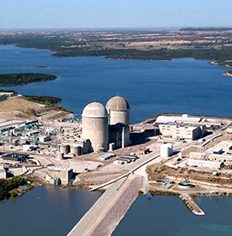
From the time Stephen F. Austin began settling folks in Texas; one of their biggest concerns was finding and
maintaining sufficient drinkable water. With only one natural lake in the state, settlers were forced to depend on less than dependable rivers or the problematic process
of digging a well through limestone.
Stubbornly, they managed to survive the flooding and droughts that alternately plagued the state.
By 1929, the Texas Legislature took steps to begin taming this tenacious water supply with the creation of the Brazos River Authority.
As the first agency in the country with the mission to develop, manage and protect the water resources of an entire river basin,
the fledgling organization began its quest to corral a dependable water supply by building the Brazos basin’s first major reservoir: Possum Kingdom Lake.
In the 30 years following the 1950s' drought of record, the Authority built two additional water supply reservoirs and worked with the
US Army Corps of Engineers on 11 additional water storage and flood control projects. Along with the new lakes came a collective sigh of relief that the basin could now survive another
unthinkable drought.
Our pioneer ancestors would have marveled at the amount of drinking water now available. But with progress and development in the
ensuing 200 years came a demand for water reaching much farther into our daily lives than a simple faucet and cup.
Today, the Authority makes water available within the basin not only for drinking purposes, but for everything from farming and
ranching to cooling and lighting our homes and producing the rock that adorns trendy homes and businesses.
Implementing the management aspect of its mission, the Authority makes water available through contracts for the sale of nearly 700,000 acre-feet
of state-permitted water. * These agreements are for varied uses that fall into one of four areas: municipal, industrial, irrigation and mining.

Municipal Use
Municipal contracts constitute the largest number of agreements issued by the Authority. These contracts allow cities,
such as Granbury, Temple, Georgetown and Brenham to obtain Brazos basin water for a variety of purposes benefiting residents, such as public water supply. Also included in this
group are municipal utility districts, water authorities and others who supply water for use in municipal areas.
Last year’s drought greatly affected many Brazos basin cities; especially those located in the central basin.
As the drought progressed nearly emptying Lake Georgetown through evaporation and use, the Authority was able to augment the available water supply by moving water stored at
Lake Stillhouse Hollow to Lake Georgetown through a pipeline built specifically for this purpose in 2003. This water, coupled with conservation efforts, helped the area through the
new drought of record.

Industrial Use
Industrial contracts account for a large portion of water sold by the Authority. Customers with this type of
contract use water for a variety of manufacturing operations, from chemical production to producing aluminum.
The Authority's largest users also include energy producers that operate power plants. In this case, water and electricity do mix and water is an
essential ingredient in power production.
In coal and gas power plants, water is pumped into a boiler, where it is heated by burning coal or gas.
This produces high-pressure steam, which pushes the blades of a turbine, generating electricity.
A similar process is used in nuclear power plants. Water is also used to cool the reactor; to help moderate the heat generated by nuclear reactions.

Irrigation Use
The Authority’s irrigation contracts are issued to those requiring water for commercial production of plants or crops.
Farmers and ranchers have irrigation contracts with the Authority, as do commercial nurseries and turf and plant growers.
For example, one group of growers in Central Texas have formed an irrigation company, which contracts with the Authority for
water allowing smaller producers to grow everything from watermelon to peanuts supplying fruit stands and supermarkets. To the south, another contract supplies water to a pecan
grower who is able to produce several varieties of pecans from his orchard for public sale.
Irrigation contracts also supply resorts, hotels, senior living communities and even a lakeside church camp.

Mining Use
Mining water contracts are issued for water used to extract coal, minerals and other substances from the ground, including
oil and gas operations. Water is also used in mining to help separate the desired rock or substance from other unwanted materials.
A popular material for building and signs, Texas limestone and other decorative rock are quarried with water supplied by contract.
Companies that contract for water also produce aggregate, a mix of gravel, crushed stone and sand that can be used in water purification, erosion control, roads, bridges, runways and parking
lots to name a few.
In a state where water has always been a scarce resource, ensuring supply to all continues to be a challenge.
As our population continues to grow and technology changes, new uses for water and finding new sources of water, will continue to drive the Authority’s mission.
* An acre-foot is the amount of water that would cover an area one acre to a depth of one foot, or about 325,851 gallons.